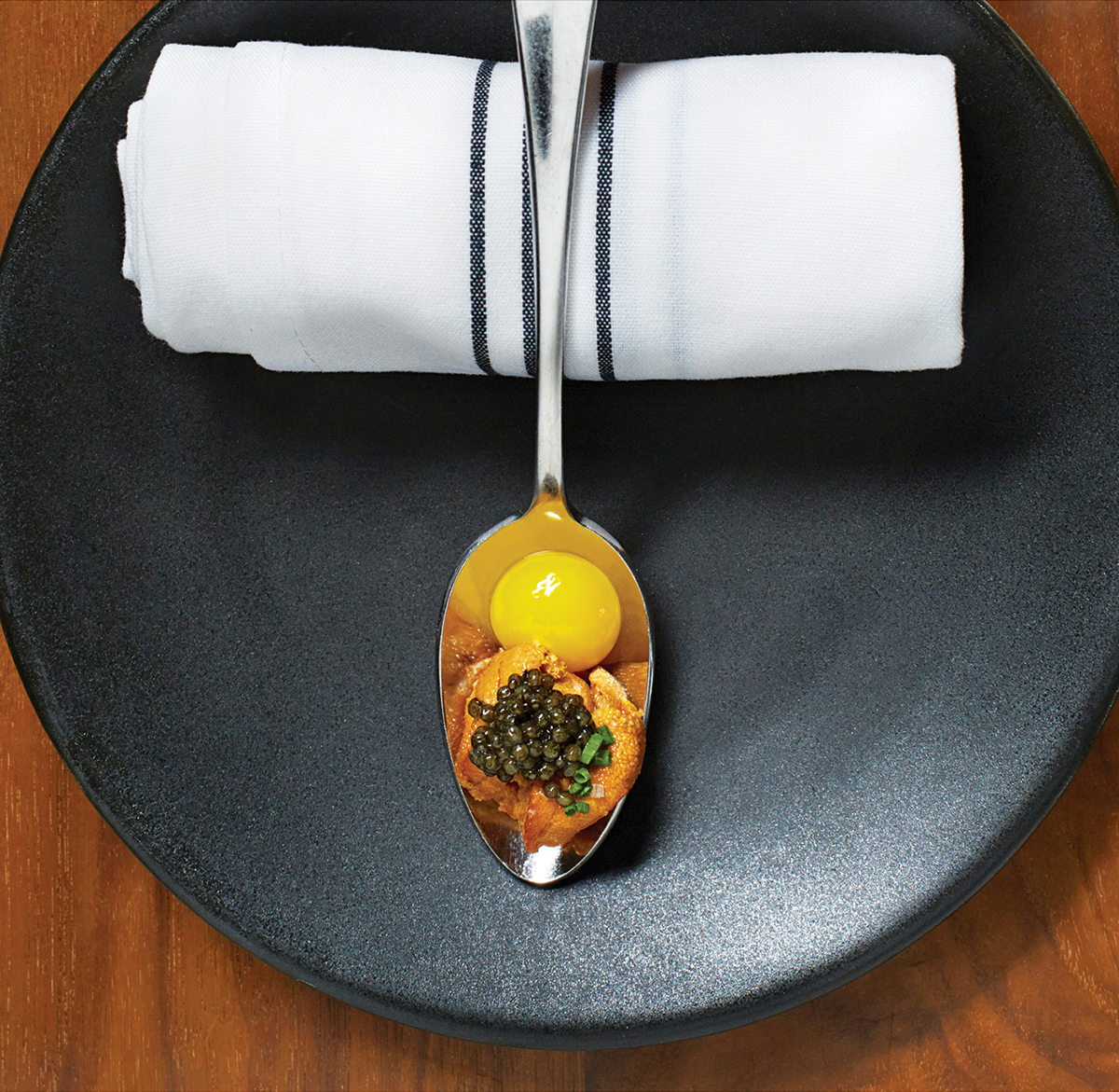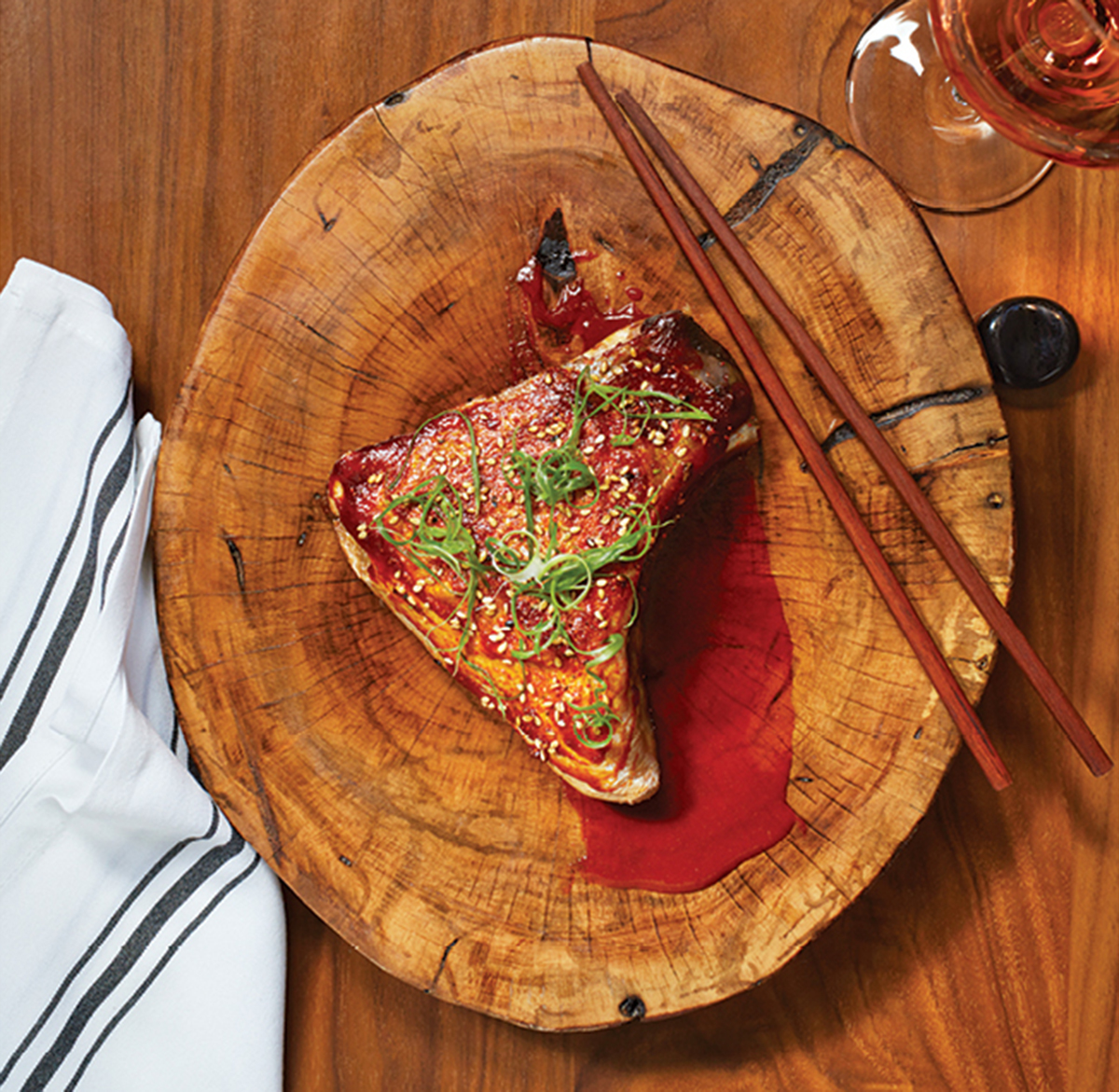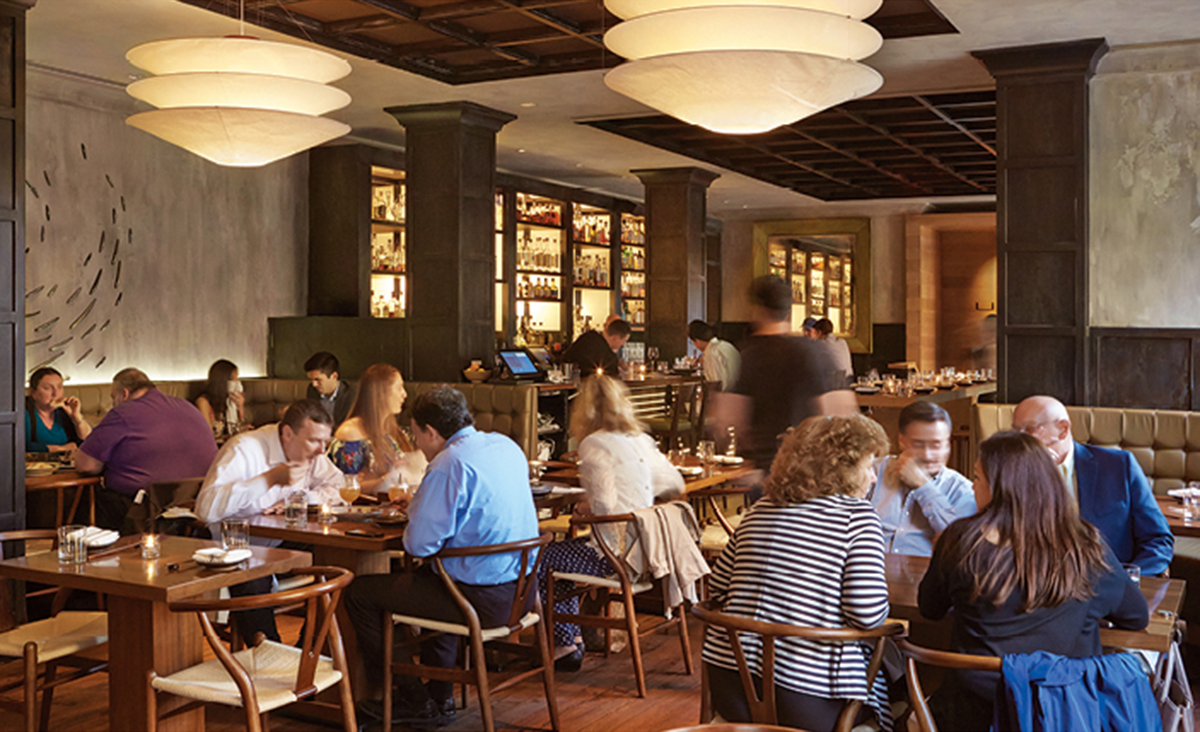Restaurant Review: Uni

Uni’s signature smoked uni spoon with quail egg and caviar. / Photograph by Nina Gallant
Sometimes we all need to distance ourselves from the familiar—to break boundaries and go wild. That’s what Ken Oringer and Tony Messina have done at Uni 2.0., where very little resembles (or even aspires to resemble) the typical contemplative sushi experience. No, this is two unapologetic chefs having freewheeling fun riffing off what they know and have learned: the techniques and ingredients of Japan, but also of Spain, Italy, and even France. It’s as if a bunch of western sushi masters decided to rock out and say, “The hell with staid tradition!”
Full disclosure: I was always put off by Uni’s previous iteration, a cramped, 23-seat matchbook of a restaurant located just a few steps down from Clio. Oringer’s bar had the vibe of a too-cool-for-you industry hang—the kind of chefs-only club where you feel like you have to flash at least a quarter-sleeve tattoo to get in. So when Clio closed in a gust of publicity, I was admittedly indifferent to the potential of a vastly expanded Uni, which would be taking over all 98 seats of the combined space. A sushi agnostic, I don’t often find myself craving, say, the salmon-avo aburi maki at Café Sushi. I recognize the virtues of the utterly artisanal approach to sashimi and Japanese cuisine at O Ya—where dozens of sauces and condiments are made by hand. And I’ll gladly go to the prohibitively expensive Oishii…when someone else is paying.
It turns out, coincidentally, that I’m the perfect Uni customer. Oringer and Messina don’t want to impress diners with fanatical purity, fabulous technique, or super-rare fish you can get only from Tsukiji, the famous Tokyo fish market—though all of that is on display. They want you to be open and ready for a good time. I’m not sure I’ve ever seen Oringer this relaxed and in his element.
Why am I so surprised? Toro, Oringer’s South End tapas bar, is perpetually crowded and raucous. But it’s also more rules-bound. I fell in love with it from the minute it opened—like every gastronaut at the time—for its pitch-perfect renditions of Barcelona’s plancha-grilled seafood-and-ham combinations. But the menu sticks much more closely to the strictures of tapas and pintxos. The chefs color inside the lines. Coppa, the South End trattoria Oringer partnered with the talented Jamie Bissonnette on, was just as packed upon its opening. But the offal, the salumi, the pastas—all of them lusty and pretty much all of them terrific—also hew closely to the restaurant’s Roman-themed model.

Grilled hamachi kama. / Photograph by Nina Gallant
Uni, on the other hand, breaks through the looking glass. It uses the familiar building blocks of Japanese cuisine that give us the umami we’ve come to crave—dashi, dried mushrooms, and yuzu juice, which Messina, the executive chef and partner, relies on to brighten many dishes on the menu. But the chefs don’t stop there. Why not bring in a little bacon or prosciutto for some added umami? Or how about crème fraîche to lend some heft and creaminess when tofu and Kewpie mayo aren’t quite lush enough?
The menu at Uni is sprawling—way too big to get through in two or even three visits. And it certainly has misses, something that’s a guarantee with such a kaleidoscopic approach. But at $8 to $16 for many plates, it invites experimentation, which makes it easy to develop your own curated list of favorites.
One you’ll finish in a single greedy gulp is the smoked uni spoon ($16)—very lightly smoked sea urchin served with raw quail egg and a dollop of osetra caviar. The commingling of smoke, brine, and grassy quail yolk can make converts out of even the most adamant uni haters, Messina told me. But when it comes to Oringer’s love of sea urchin, I happen to prefer the franker marine flavor of the uni nigiri ($11), with its tiny square of prosciutto and finishing splash of sweet vin cotto. Both are adroit introductions to the East–West tapestry the chefs weave throughout the menu. So is the grilled asparagus with Camembert-tofu emulsion ($10), something that is far more appetizing than it sounds—the asparagus grilled over scalding coals and coated with a mixture of cheese, tofu, and cream. The brightening accent of minty shiso leaf shows how the chefs use such a wide range of elements to push something simple into another stratosphere.
Smoked hamachi tartare ($16) is another exemplar of subtlety, the cold smoke of the fish brightened by yuzu juice and a marvelously creamy binder of labne and olive oil. The smoked uni spoon, like Thomas Keller’s salmon cornets at the French Laundry, might be the house signature, but the tartare nestled inside a little fluted nori cup is my nomination to replace it.

Inside the revamped space. / Photograph by Nina Gallant
Hot plates are where the chefs play with the strongest flavors. You’ll need to brace your taste buds for the fiery Chinese chilies and startlingly hot cumin on the Yunnan eggplant salad ($8), though the almond romesco deftly plays up the already creamy slices of eggplant. Shishito peppers ($8) are a more temperate alternative, with a light glaze of sweet kabayaki sauce, sesame seeds, and smoked sea salt. Best of the hot entrées was grilled hamachi kama ($20), a succulent piece of yellowtail collar marinated in ginger, soy, and mirin, then burnished with a Korean-style chili vinaigrette. Along with more classic nigiri and makimono, such as an unagi roll with crunchy bits of fried tempura ($16), this was classic Japanese fusion—or classic-ish.
But it’s the instances where Messina and Oringer veer further astray—salmon skin with mustard greens ($8)—that led me back for the fourth, and even fifth, time. One example: the sashimi of Spanish sea bass paired with a North African mix of preserved lemon, chopped sultanas, and two jade-green herb sauces, gremolata and chermoula ($16). Another was the sea bream sashimi ($16) with currants and Moroccan ras el hanout.
See what I mean about not wanting to stop? You’ll probably want to dodge some of the fire (e.g., eggplant salad) and the longtime Uni standard of tako (a barely warmed raw octopus sashimi with barrel-aged tamari, $16), which actually made me decide on a temporary cephalopod moratorium. But dessert will make up for it, like the must-have kouign-amann held over from Clio and a Klondike bar with a magic chocolate shell around coconut ice cream (both $8).
Uni, then, is an adventure. It bears the marks of exhilarated chefs busting loose—and that exhilaration is infectious.
★ ★ ★
370 Commonwealth Ave., Boston, 617-536-7200, uni-boston.com.
Menu Highlights
Smoked uni spoon, $16
Grilled hamachi kama, $20
Spanish sea bass sashimi, $16
Critic Corby Kummer is an editor at the Atlantic and the author of The Joy of Coffee and The Pleasures of Slow Food.
★★★★ Extraordinary | ★★★ Generally Excellent | ★★ Good | ★ Fair | (No Stars) Poor


